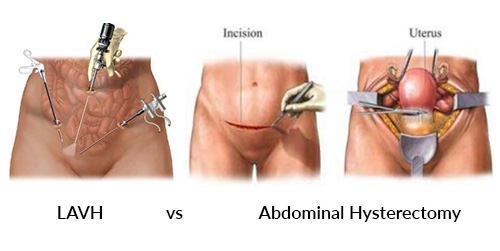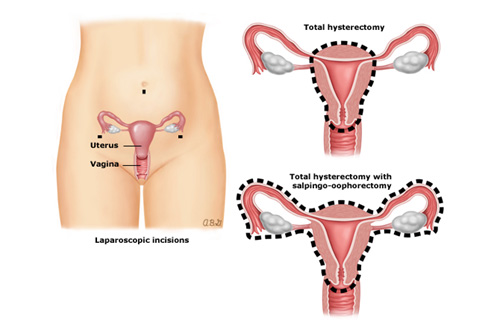Laparoscopic Hysterectomy (LAVH)
What is a Laparoscopic hysterectomy (LAVH)?
The LAVH is minimally invasive procedure to remove the uterus though small incisions, compared to the abdominal hysterectomy. The LAVH procedure requires 3 small one cm incisions in the abdomen. The body of the uterus is removed along with bilateral fallopian tubes. The ovaries are either saved or removed, depending upon the age and personal preference of the patient.

What are the advantages of the Laparoscopic Hysterectomy (LAVH)?
- Smaller incisions (1 cm) which allows for a quicker post-operative recovery, with less post-operative pain, compared to the abdominal hysterectomy.
- Shorter hospital stays (e.g. 1 night in the hospital) and patients go home the next day. The patient should be able to resume close to normal activities in 2-4 weeks.
- Fewer surgical complications (e.g. less blood loss, decreased risk of infection, and decreased post-operative adhesions).
Different types of LAVH procedure (+/- removal of fallopian tubes and ovaries)
a. LAVH with DEFINITIVE bilateral salpingectomy means removal of the uterus and removal of both fallopian tubes only. The ovaries are preserved. Nowadays, the fallopian tubes are ALWAYS removed at the time of the hysterectomy to decrease the risk of fallopian tube cancer.
b. LAVH with DEFINITIVE bilateral salpingo-oophorectomy (BSO) means removal of the uterus and removal of bilateral tubes and ovaries at the same time.

What are the advantages and disadvantages of removing the ovaries?
- If a patient is less than 50 years old with no history of ovarian disease, the goal is to SAVE bilateral ovaries.
- If the patient is over 60 years old, then traditionally, the ovaries are removed at the same time as the hysterectomy. The ovaries produce minimal to no hormones after 60 years old.
- If the patient is between 50-60 years old, then the removal of the ovaries is the judgement call of the patient.
- If the ovaries are SAVED, the advantage is LESS menopausal symptoms (e.g. hot flashes, insomnia, night sweats, mood swings, etc.) The disadvantage is that there is a higher risk of ovarian cancer or ovarian cyst formation in the future.
- If the ovaries are REMOVED, the advantage is no risk of ovarian cancer and no risk of ovarian cyst formation. The disadvantage is possibly worsening menopausal symptoms.